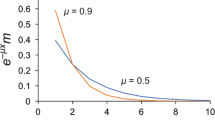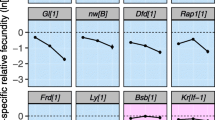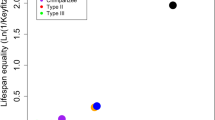Abstract
Senescence is the post-maturation decline in survivorship and fecundity that accompanies advancing age. Two main evolutionary theories have been proposed to account for senescence. (1) The mutation-accumulation theory. Deleterious mutations exerting their effects only late in life would tend to accumulate, because of their minimal effects on fitness1,2. More precisely, exclusively late-acting deleterious mutations will attain higher equilibrium frequencies under mutation–selection balance than will mutations that act early, resulting in lower mean values for fitness components late in life (ref. 3, p. 218). Medawar1 emphasized the possibility that this effect would be enhanced by selection of modifiers that postpone the age of onset of genetic diseases. (2) The pleiotropy theory. Williams4 suggested that many of the genes with beneficial effects on early fitness components have pleiotropic deleterious effects on late fitness components, but are nevertheless favoured by natural selection. (These theories are based on the decline with age in the effect of age-specific fitness-component changes on total fitness3 (ref. 3, pp. 206–214 and refs 4, 5). Either or both of these theories could apply in any particular population.) Selection experiments in Drosophila6 and Tribolium7 support the pleiotropy theory, although one such experiment gave results that only bordered on significance8, but the mutation–accumulation theory has never been tested. The present results provide evidence for the pleiotropy theory, but do not support the mutation–accumulation theory.
Similar content being viewed by others
References
Medawar, P. B. An Unsolved Problem of Biology (Lewis, London, 1952); The Uniqueness of the Individual (Methuen, London, 1957).
Edney, R. B. & Gill, R. W. Nature 220, 281 (1968).
Charlesworth, B. Evolution in Age-Structured Populations (Cambridge University Press, 1980).
Williams, G. C. Evolution 11, 398–411 (1957).
Hamilton, W. D. J. theor. Biol. 12, 12–45 (1966).
Wattiaux, J. M. Evolution 22, 406–421 (1968).
Sokal, R. R. Science 167, 1733–1734 (1970).
Mertz, D. B. Physiol. Zool. 48, 1–23 (1975).
Ives, P. T. Genetics 30, 167–196 (1945); Evolution 24, 507–518 (1970).
Falconer, D. S. Introduction to Quantitative Genetics (Oliver & Boyd, Edinburgh, 1960).
Mukai, T., Cardellino, R. A., Watanabe, T. K. & Crow, J. F. Genetics 78, 1195–1208 (1972).
Wright, S. in Quantitative Inheritance (eds Waddington, C. H. & Reeve, E. C. R.) 5–41 (HMSO, London, 1952); Evolution and the Genetics of Populations Vol. 1, 232 (University of Chicago Press, 1968).
Kempthorne, O. An Introduction to Genetic Statistics (Wiley, New York, 1957).
Mahumunulu, D. M. Ann. math. Statist. 34, 521–527 (1963).
Lints, F. A. Genetics and Ageing (Karger, Basel, 1978).
Lints, F. A. & Hoste, C. Evolution 31, 387–404 (1977).
Comfort, A. Nature 172, 83 (1953).
Rose, M. R. & Charlesworth, B. Genetics (in the press).
Author information
Authors and Affiliations
Rights and permissions
About this article
Cite this article
Rose, M., Charlesworth, B. A test of evolutionary theories of senescence. Nature 287, 141–142 (1980). https://doi.org/10.1038/287141a0
Received:
Accepted:
Issue Date:
DOI: https://doi.org/10.1038/287141a0
- Springer Nature Limited
This article is cited by
-
Meta-analysis shows no consistent evidence for senescence in ejaculate traits across animals
Nature Communications (2024)
-
Do Longevity and Fecundity Change by Selection on Mating Success at Elevated Temperature? Correlated Selection Responses in Drosophila buzzatii
Evolutionary Biology (2021)
-
Nontraditional systems in aging research: an update
Cellular and Molecular Life Sciences (2021)
-
Epigenetic changes during ageing and their underlying mechanisms
Biogerontology (2020)
-
Telomeres and telomerase: three decades of progress
Nature Reviews Genetics (2019)





